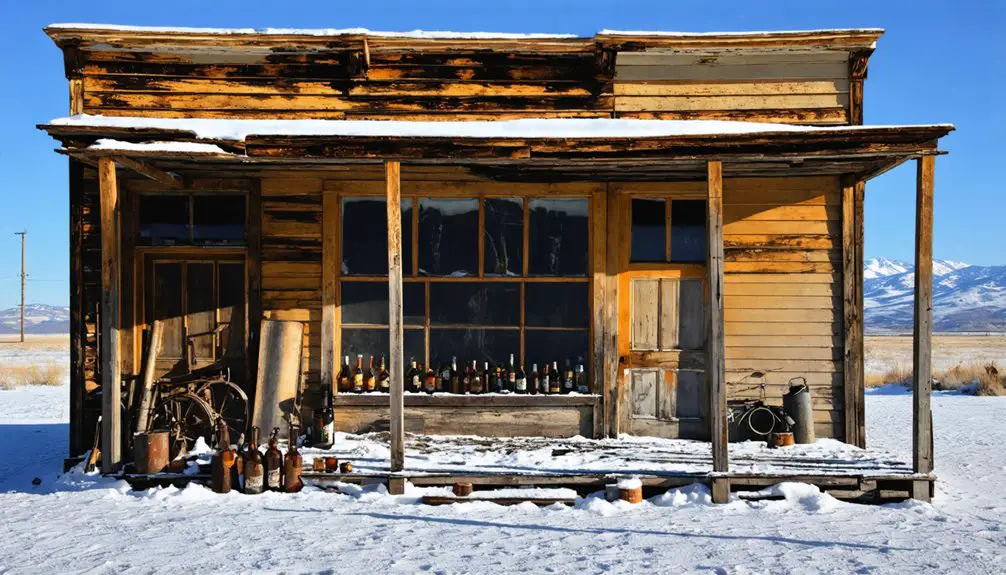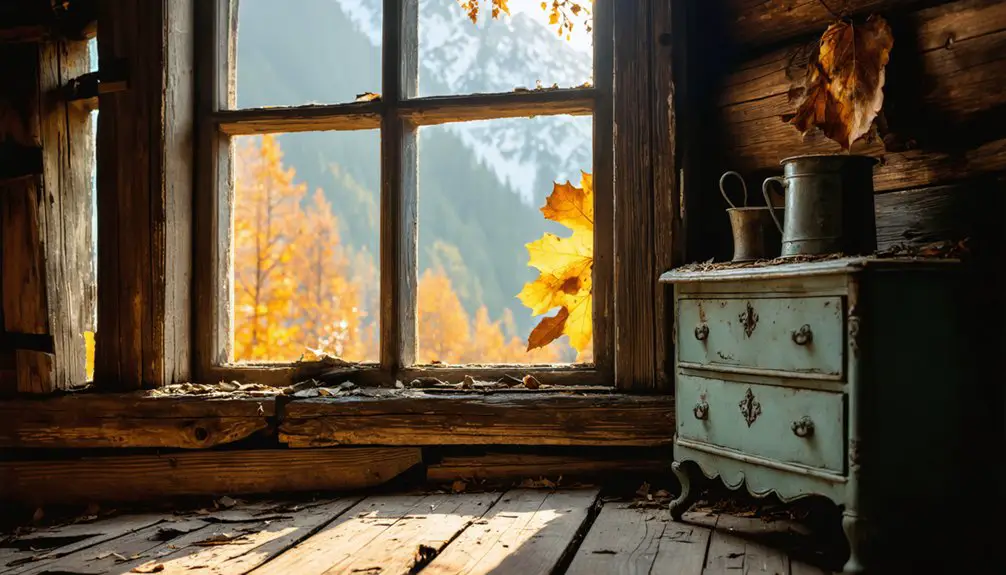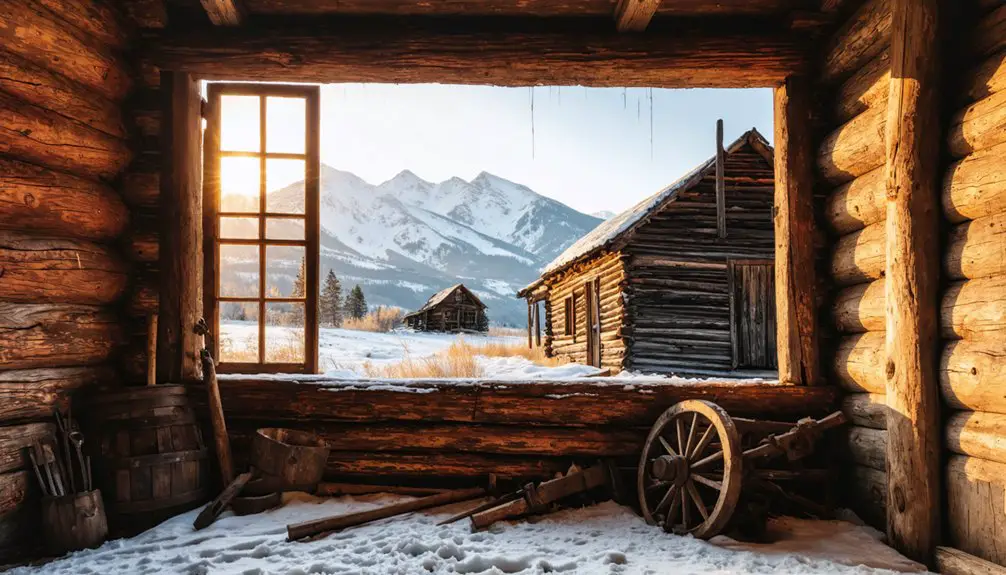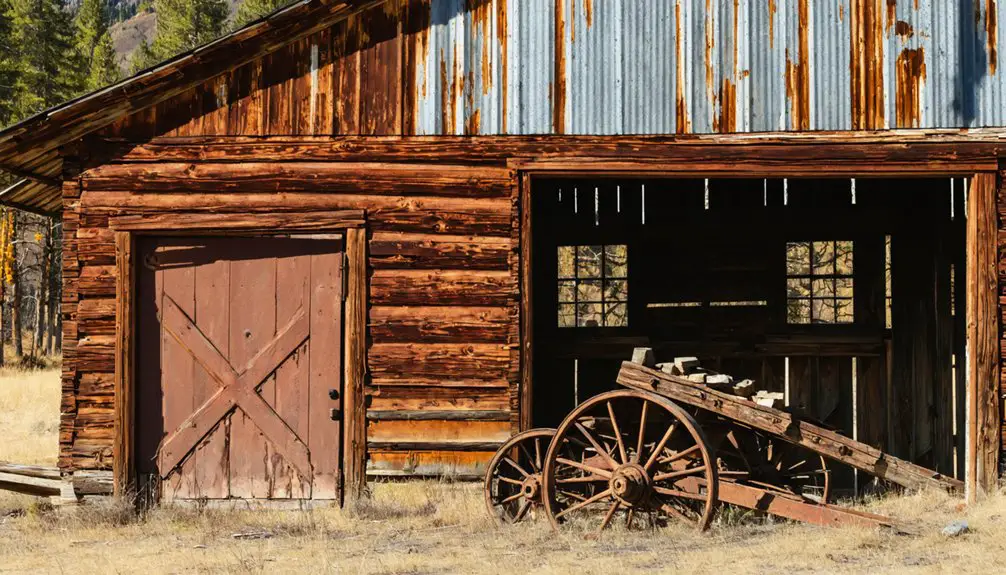You’ll find Garnet, Montana’s best-preserved ghost town, nestled in the Garnet Mountains where gold was discovered in the mid-1860s. After the 1893 repeal of the Sherman Silver Purchase Act, the town boomed to over 1,000 residents by 1898, featuring saloons, hotels, and a vibrant mining community. While a 1912 fire and depleted gold veins led to its abandonment by 1948, today the Bureau of Land Management protects about 80 historic structures that tell fascinating stories of Montana’s golden age.
Key Takeaways
- Garnet is a well-preserved Montana ghost town that boomed during the 1890s gold rush, reaching over 1,000 residents by 1898.
- The town declined after a devastating 1912 fire and the depletion of gold mines, with final abandonment marked by a 1948 auction.
- About 80 wooden-frame buildings remain, showcasing frontier architecture and mining-era structures like Kelley’s Saloon and the Miners Union Hall.
- The Bureau of Land Management and Garnet Preservation Association maintain the site, offering seasonal tours and educational programs.
- Visitors can explore historic structures, pan for gold, and participate in Garnet Day celebrations, with access limited during winter months.
The Birth of a Golden Boomtown
While gold prospectors first discovered placer deposits in the Garnet Mountains during the mid-1860s, it wasn’t until the 1893 repeal of the Sherman Silver Purchase Act that Garnet truly emerged as a bustling boomtown.
The initial gold discovery in Bear Creek and Bear Gulch attracted early miners who worked the streams with pans, rockers, and sluice boxes. When these surface deposits ran dry, prospectors turned their attention to the gold-bearing quartz veins in the surrounding mountains. The Nancy Hanks mine produced an impressive $300,000 in gold during its operation.
You can trace Garnet’s boomtown growth to the influx of unemployed silver miners who flocked here after the 1893 silver crash. The rush of newcomers transformed this remote mining camp into a proper town, complete with a post office by 1896, multiple saloons, boarding houses, and a school. The population quickly swelled, reaching over 1,000 residents by 1898.
Life in Montana’s Mining Haven
While miners toiled during daylight hours, their families maintained households and children attended the local school, creating a stable community atmosphere unusual for frontier mining towns.
You’d find the streets of Garnet bustling with activity as residents moved between essential services like the barber shop, hotels, and stables during business hours. The town reached its peak when 1,000 residents called it home in 1898.
After sunset, the town’s numerous saloons and bawdy houses came alive, offering entertainment and social connections despite the remote mountain setting. The Miners Union Hall became a central gathering spot where locals enjoyed dances and community celebrations.
Mining Families’ Daily Routines
During the 1890s, mining families in Garnet established daily routines that balanced hard labor with domestic life.
You’d find parents rising early to handle essential tasks – fathers heading to mining claims while mothers managed family chores like cooking, laundry, and food preservation.
Children split their time between attending the local school and enjoying outdoor activities such as fishing and sledding.
Life required self-sufficiency at 6,000 feet elevation. You’d need to hunt, fish, and tend gardens to supplement your food supplies, especially before harsh mountain winters set in.
In the evenings, families gathered for dinner parties, card games, and community events at the Miners Union Hall.
Children’s play often involved seasonal activities – summer picnics and hayrides gave way to winter sleigh rides and skiing.
The town’s four active hotels provided comfortable lodging for visiting miners and businessmen seeking their fortunes in Garnet.
A devastating fire in 1912 destroyed half of the town’s buildings, forcing many families to relocate and rebuild elsewhere.
Social Activities After Dark
As the sun set behind Garnet’s mountain peaks, the town’s social life sparked to life in its numerous entertainment venues.
You’d find miners and families gathering at Kelley’s Saloon for live music, while others sought entertainment at any of the 13 bars or four hotels scattered throughout town.
During Prohibition, the Dahl cabin’s speakeasy kept nighttime gatherings alive.
The community balanced freedom with order, maintaining safety through a local jail while allowing regulated gambling and socializing.
You might’ve joined organized dances, shared meals, or listened to storytelling at community halls.
Today, these same venues are said to host ghostly encounters – from mysterious piano music at Kelley’s Saloon to unexplained footsteps in the Wells Hotel, keeping Garnet’s spirited nightlife alive in a different way.
Every spring, visitors can experience a taste of the town’s communal spirit during Garnet Day celebration, which features historical demonstrations and speakers.
With a peak population of 1,000 by 1898, the town bustled with social activity as families and children added to the vibrant community atmosphere.
Architecture and Building Legacy
Since its establishment in the late 19th century, Garnet’s architectural legacy has primarily consisted of wooden-frame structures built for quick utility rather than lasting beauty. The building techniques reflect the urgency of the mining boom, with most structures lacking proper foundations. Just as historic garnets were used for abrasive sand blasting, many of the town’s original wooden structures had to be sanded and restored over time.
Today, you’ll find about 80 buildings showcasing the architectural significance of this frontier town. A devastating fire in 1912 destroyed several original structures, forever altering the town’s architectural landscape.
- Two-story saloons featured separate spaces for men and women
- Commercial buildings incorporated wooden sidewalks and simple storefronts
- Residential cabins maintained small, practical layouts for harsh mountain living
- Key structures like Kelley’s Saloon and Davey’s Store exemplify late 1890s frontier design
- Original weathered wood and wear remain visible, preserving authentic historical character
The Bureau of Land Management now maintains these structures, balancing preservation with safety while keeping Garnet’s mining-era charm intact.
Tales From the Underground
You’ll find that Garnet’s underground mining operations evolved from simple placer mining to complex hard rock extraction, with miners pursuing gold-bearing quartz veins deep beneath Garnet Mountain.
Working conditions in these narrow, dark tunnels were primitive and dangerous, requiring backbreaking manual labor with basic tools and minimal mechanization.
Mining Life Below Ground
While the gold rush of the 1860s began with surface placer mining, Garnet’s true underground story emerged when miners shifted to pursuing gold-bearing quartz veins deep within the mountains.
You’ll find that mining techniques evolved from simple arrastras to more sophisticated methods like the 10-stamp mill built in 1894.
Underground dangers were constant companions in the cramped, dark tunnels where miners worked at 6,500 feet elevation.
- Hauling ore relied heavily on manual labor and mule power
- Most mines yielded 95% gold, with silver and copper as secondary finds
- The 1893 Sherman Act’s repeal drove silver miners to Garnet’s gold deposits
- Early extraction methods were primitive, limiting initial development
- Mining shafts lacked permanent infrastructure, reflecting the transient nature of operations
Gold Rush Work Hazards
The dangerous realities of underground mining in Garnet extended far beyond the physical challenges of excavation.
You’d face constant exposure to hazardous chemicals like mercury and cyanide, which miners handled without proper protective equipment. These toxins contaminated workers’ bodies through air, diet, and direct contact, while also polluting local water sources.
Underground, you’d battle deadly threats from unstable tunnels, flying rock from dynamite blasts, and falls from precarious heights.
The crushing and milling of rock produced silica dust that led to devastating respiratory diseases like silicosis and tuberculosis. Working in confined spaces, you’d breathe particulate matter and toxic fumes that contributed to chronic bronchitis and lung cancer.
Without regulated safety programs or proper gear, miners faced markedly shortened life expectancies from these combined risks.
The Great Decline and Abandonment

After reaching its peak around 1900, Garnet’s slow descent into abandonment began as easily accessible gold veins became depleted, leaving only costly deep mining operations viable.
The town faced multiple economic downturns and population shifts as World Wars I and II drew residents away for military service and war-related employment. A devastating fire in 1912 destroyed much of the commercial district, accelerating the decline.
- Mining restrictions during WWII limited use of essential materials like dynamite
- The Montana School of Mines declared the gold mines “dead” by 1960
- Souvenir hunters stripped abandoned buildings of doors, fixtures, and woodwork
- Harsh mountain climate and erosion deteriorated remaining structures
- A brief 1934 revival ended when WWII began
The town’s final abandonment was marked by a 1948 auction of remaining store items, concluding Garnet’s mining era.
Preserving a Piece of Western History
Despite Garnet’s decline into abandonment by 1948, dedicated preservation efforts beginning in 1970 have transformed this once-forgotten mining town into a protected historical treasure.
The Garnet Preservation Association and Bureau of Land Management work together to safeguard this piece of Montana’s heritage through restoration projects, interpretive programs, and community engagement.
You’ll find carefully stabilized historic buildings, including the jail, post office, and hotel, all maintained using authentic materials to preserve their early 20th-century character.
The site’s heritage preservation extends beyond physical structures through oral history projects and educational programs that bring the gold rush era to life.
Volunteers play a significant role in Garnet’s ongoing care, participating in maintenance work days and helping with interpretive activities.
You can even stay overnight in primitive winter cabins, experiencing the town’s rugged charm firsthand.
Whispers and Legends of the Past

From Garnet’s early days as a bustling mining settlement, mysterious legends and supernatural tales have become deeply woven into its cultural fabric.
The town’s dramatic rise and fall, coupled with its isolation at 6,000 feet, created perfect conditions for folklore origins that still captivate visitors today.
High in Montana’s rugged peaks, Garnet’s wild boom-and-bust legacy spawned enduring folklore that draws curious souls to this day.
You’ll find the most reported ghostly encounters centered around the Wells Hotel and Kelley’s Saloon, where unexplained footsteps and phantom sounds echo through empty halls.
- Mysterious footsteps vanish when approached
- Phantom doors slam where none exist
- Ghostly laughter drifts from Kelley’s Saloon
- Spirits seem tied to mining booms and busts
- Most encounters are auditory rather than visual
These stories aren’t just tales of haunting – they’re preserving the memory of frontier life and the countless souls who sought their fortunes in Garnet’s mountains.
Seasonal Adventures and Tourism
While Garnet Ghost Town welcomes visitors year-round, its accessibility and activities vary dramatically with the seasons.
You’ll find peak visitor engagement from spring through fall when the town’s 30 historic buildings and extensive trail network are fully accessible via Highway 200 and Garnet Range Road.
Don’t miss June’s Garnet Day, featuring period music and historical presentations that bring the town’s mining heritage to life.
During the warmer months, you can explore 30 miles of backcountry trails, try gold panning, or fish for trout in Elk Creek.
The $3 day-use fee supports site preservation, giving you access to picnic areas, potable water, and self-guided tours.
Winter visits become challenging as snow makes roads impassable, limiting seasonal activities to the most adventurous travelers.
Mining Methods and Economic Impact

Before Garnet became a bustling mining town, early prospectors relied on simple placer mining techniques to extract gold from local waterways.
You’ll find evidence of their resourcefulness in the remnants of sluice boxes, rockers, and small dams they built to divert water for mining operations.
As surface gold depleted, miners shifted to hard rock mining in the 1870s, targeting gold-bearing quartz veins.
This change transformed Garnet’s economy and sparked significant population growth, reaching 250 residents by 1936.
- Initial placer mining operations relied on portable equipment like gold pans and sluices
- Water management systems were essential for successful gold recovery
- Discovery of quartz veins prompted shift to more complex hard rock mining
- Poor road conditions initially limited large-scale mining equipment transport
- Mining prosperity supported development of schools, saloons, and merchants
Frequently Asked Questions
What Wildlife Can Visitors Commonly Encounter Around Garnet Today?
Quick as lightning, you’ll spot wildlife sightings from mountain chickadees to black bears. You’re likely to observe elk and deer’s natural animal behavior, while grizzlies, mountain lions, and lynx roam nearby.
Are There Any Camping Facilities or Overnight Accommodations Near Garnet?
You’ll find diverse camping options from primitive winter cabins and dispersed camping to nearby RV sites. For more comfortable lodgings, there’s Lost Moose Meadows campground and upscale dude ranch resorts.
How Many Deaths Were Recorded in Garnet During Its Active Years?
You’ll find no official death count in Garnet’s history records. While mining accidents, illness, and the 1912 fire likely claimed lives in this ghost town, exact numbers weren’t systematically documented.
What Happened to the Town’s Original Cemetery and Burial Records?
You won’t find the original cemetery today due to natural deterioration and rocky terrain. Most burial records were lost when the town emptied, though some may exist in county archives.
Can Visitors Take Home Artifacts They Find at the Ghost Town?
No, you can’t take artifacts home. Legal regulations strictly prohibit removing any historical objects. You’re welcome to photograph items, but artifact preservation laws require everything to stay where it’s found.
References
- https://www.garnetghosttown.org/history.php
- https://en.wikipedia.org/wiki/Garnet
- https://www.roadunraveled.com/blog/garnet-ghost-town-montana/
- https://www.legendsofamerica.com/mt-garnet/
- https://www.youtube.com/watch?v=LbZYI-pmH2I
- https://westernmininghistory.com/towns/montana/garnet/
- https://southwestmt.com/blog/montanas-garnet-ghost-town/
- https://www.blm.gov/sites/default/files/docs/2021-07/THE ROAD TO GARNET’S GOLD (002).pdf
- https://app.mt.gov/shop/mhsstore/the-road-to-garnets-gold-a-brief-history-of-montanas-gold-rush-featuring-one-of-the-last-ghost-towns
- https://southwestmt.com/specialfeatures/this-is-montana/special-places/garnet-ghost-town/



